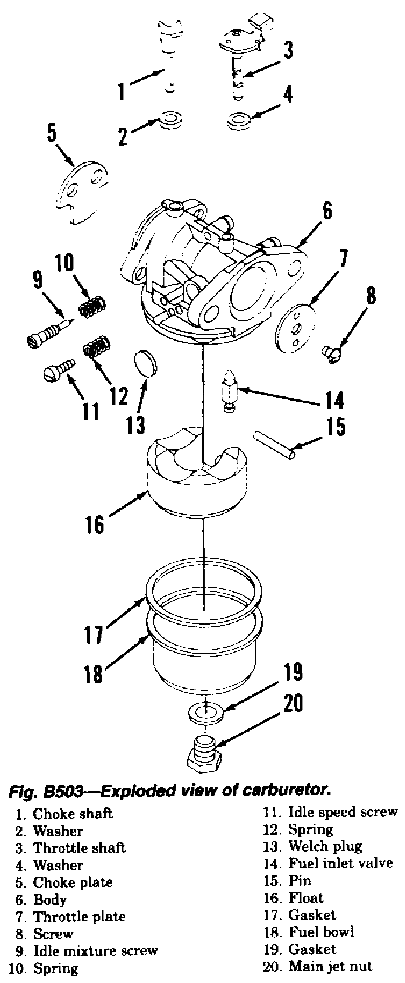– Directory – |
– Auto & Repair – |
Lawnmowers |
– Repair |
Basic Briggs & Stratton float type carburetor. |

Item 20 in the above diaghram has to be clean for the motor to run more than a few
seconds. This is the same setup as on the Tecumseh carburetor page. Looks a little
different but the same principal pertains to both carburetors. |
• Starting |
• Adjusting The Idle Speed And Mixture On some float-type carburetors, you can adjust the air-fuel mixture and engine speed at idle. Check for an idle speed screw designed to keep the throttle plate from closing completely, and an idle mixture screw that limits the flow of fuel at idle. If your carburetor contains these screws, proceed below. With the engine off, remove the air filter and air cartridge. Locate the idle mixture screw and turn it clockwise until the needle lightly touches the seat. Then, turn the screw counterclockwise 1-1/2 turns. If your carburetor has a main jet adjustment screw at the base of the float bowl, turn the screw clockwise until you feel it just touch the seat inside the emulsion tube. Then, turn the screw counterclockwise 1 to 1-1/2 turns. Replace the air cleaner assembly and start the engine for final carburetor adjustments. Run the engine for five minutes at half throttle to bring it to its operating temperature. Then, turn the idle mixture screw slowly clockwise until the engine begins to slow. Turn the screw in the opposite direction until the engine again begins to slow . Finally, turn the screw back to the midpoint. Using a tachometer to gauge engine speed , set the idle speed screw to bring the engine to 1750 RPM for aluminum-cylinder engine or 1200 RPM for engine with a cast-iron cylinder sleeve. With the engine running at idle , hold the throttle lever against the idle speed screw to bring the engine speed to "true idle." Then, repeat the idle mixture screw adjustments from Step 4 to fine-tune the mixture . |
•Troubleshooting A Fuel Supply Problem Remove the air cleaner and inspect the choke plate mounted on a shaft at the opening of the carburetor's throat . Check that the choke plate closes easily and completely. A choke that does not move freely or close properly can cause difficulties in starting. Spray a small amount of carburetor cleaner on the shaft of a sluggish choke and into the venturi to loosen grit. Debris in the carburetor often causes performance problems. Open the fuel valve (if equipped), located at the base of the fuel tank where the fuel line is attached. Remove the line and check for blockage . Fuel will not reach the carburetor if the fuel valve is closed. If the engine is equipped with a fuel pump, make sure it operates properly. Remove and inspect the spark plug. A wet plug may indicate over-choking, water in the fuel, or an excessively rich fuel mixture. A dry plug may indicate a plugged fuel filter, leaking mounting gaskets on either end of the carburetor, or a stuck or clogged carburetor inlet needle. Pour a teaspoon of fuel into the spark plug hole . Screw the spark plug back in and start the engine. If it fires only a few times and then quits, assume a dry plug condition and consider the causes of a dry plug, listed in Step 5. |
Carburetor Troubleshooting |
• |
• |
• |
• |
• |
• |
• |
– Home Repair Tips – |
* |
* |
* |
* |

Search Small Engine Repairs |

Search Small Engine Repairs |